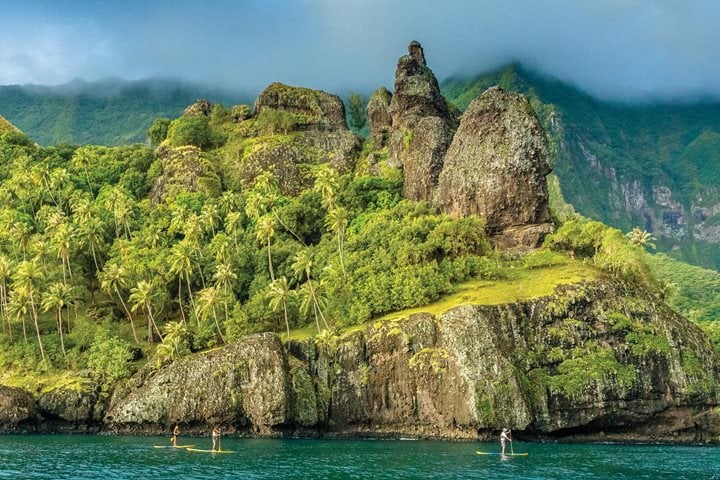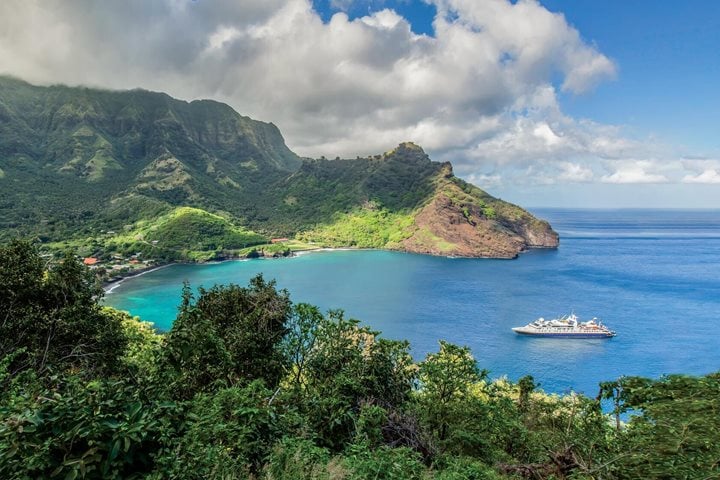Since 2015, our field correspondent Jenny Kingsley has been sharing stories from the Arctic through her journalism project Meet the North. Now she is turning her attention to warmer locales. Jenny recently joined our 17-day Azure Seas From Tahiti to the Marquesas to begin scouting for powerful, personal stories unfolding on these far-flung islands. Here, she shares her first impressions from this vibrant, new geography. Get Inspired by Photos, Videos, Webinars, Stories, and Exclusive Offers. Sign Up
Many of us could not trace the borders of French Polynesia on a map, even though it covers an area the size of Europe. Finding Tahiti is a good start. Head northeast from there into a belt of coral atolls whose lands are so narrow, so close to the ocean they sprang from, that they barely show up on the map. These are the Tuamotus, where snorkeling above reefs and through passes feels like flying.
Then head northeast again, this time far enough to find a change of wind and season, a new language and culture, and a handful of islands as high and dramatic as the atolls are low and smooth.
Photos by Eric Guth
As Lindblad Expeditions’ Field Correspondent, I spent a few weeks in the Marquesas this summer with photographer Eric Guth. Our journey began on the decks of the National Geographic Orion, where we met a new island each day. On Nuku Hiva, we visited an ancient site that extends far into the forest. No one lives here anymore, as they would have in the past, yet the dancers who came to perform matched the enormity of this complex with their energy.
On Ua Huka the next day, local carvers were preparing for an annual contest. Each year, they recreate a traditional object from a photograph. These photos show artifacts that may have disappeared or been taken to foreign museums. Now, through this contest, they are repopulating their own cultural institutions.
In a nearby bay, we cruised a sooty tern colony above a stormy coastline full of manta rays.
The far side of Hiva Oa gave us insight into local industry. Dried coconut, called copra, is critical to the local economy, and we began to learn how it is collected and dried. Coconut ovens can handle hundreds of pounds of coconut each day —which protects the harvest from rain and supports the livelihoods of many people.
Even after so many days of beauty, Fatu Hiva still came as a surprise. The layered valleys, which rise straight from the ocean, changed with each passing cloud. Showers brought rainbows.
I wondered if the main street, if I walked far enough, might take me straight to the heavens. As I rested beside a creek, a farmer came out from his land with a grapefruit for us to share. We chatted and snacked. Juice covered my hands and shirt by the time I said goodbye.
When we reached Tahuata, I thought I had a pretty good feel for the towns here, but that was before Hapatoni, where the welcome we received struck yet another chord. Eric and I traveled back to that valley, after we disembarked the Orion, to investigate that special feeling.
Jenny (second from right) gathering flowers with some locals in the village of Hapatoni.
This community reinforced to me that time is a powerful gift. It might be the best gift we have to give. In the Marquesas, I learned about what happens when we go out of our way for others — even for strangers.
It seems a fitting lesson for a place we had to go out of our way to reach.
To follow more of Jenny’s work in the South Pacific visit pacificstories.org.
Want to experience these alluring islands for yourself? Join us in the South Pacific next season on one of our 5 unique itineraries.



